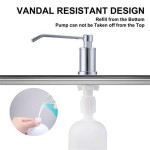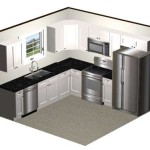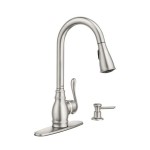Airtight Canister Sets For Kitchen: Maintaining Freshness and Organization
Airtight canister sets are essential components of a well-organized and efficient kitchen. Their primary function is to preserve the freshness of dry goods by creating a barrier against air, moisture, and pests. Beyond functionality, these sets contribute to the aesthetic appeal of the kitchen, offering a visually pleasing and uniform storage solution. The selection of an appropriate airtight canister set involves careful consideration of materials, sizes, sealing mechanisms, and overall design, ensuring they meet the specific needs of the user.
Material Considerations for Airtight Canisters
The material composition of airtight canisters significantly influences their durability, aesthetic, and suitability for storing various food items. Common materials include glass, stainless steel, plastic, and ceramic, each possessing distinct advantages and disadvantages.
Glass Canisters: Glass canisters offer transparency, allowing for easy identification of contents without the need for labels. They are non-reactive, meaning they do not impart flavors or odors to the stored food, making them ideal for storing sensitive items like coffee, tea, and spices. Glass is also relatively easy to clean and sanitize, and it is typically dishwasher-safe. However, glass canisters are more susceptible to breakage compared to other materials. Tempered glass options offer increased durability but are generally more expensive.
Stainless Steel Canisters: Stainless steel canisters are known for their durability and resistance to rust and corrosion. They are opaque, which protects contents from light degradation, making them suitable for storing items like flour, sugar, and cereals. Stainless steel is also easy to clean and maintain. However, their opacity necessitates labeling for easy content identification. The cost of stainless steel canisters can be higher than that of plastic or some glass options.
Plastic Canisters: Plastic canisters are typically the most affordable option and are available in a wide variety of shapes, sizes, and colors. They are lightweight and resistant to breakage, making them a practical choice for busy kitchens. However, the quality of plastic varies significantly. Lower-grade plastics may be prone to scratching, staining, and absorbing odors. It is crucial to select canisters made from BPA-free plastic to ensure food safety. While some plastic canisters are dishwasher-safe, prolonged exposure to high temperatures can degrade the plastic over time.
Ceramic Canisters: Ceramic canisters offer a stylish and decorative storage solution. They are available in a range of designs and finishes, making them a visually appealing addition to the kitchen countertop. Ceramic is generally non-reactive and suitable for storing a variety of dry goods. However, ceramic canisters are often more fragile than glass or stainless steel and can be prone to chipping or cracking. They are also heavier, which can be a consideration for those with limited mobility. Some ceramic canisters may require handwashing.
Sealing Mechanisms and Airtightness
The sealing mechanism is the most critical aspect of an airtight canister, as it directly determines the canister's ability to prevent air and moisture from entering and compromising the freshness of the stored contents. Several types of sealing mechanisms are commonly used in airtight canisters, each with varying degrees of effectiveness.
Silicone Gasket Seals: Silicone gaskets are widely regarded as the most effective sealing mechanism. They create a tight, airtight seal between the lid and the canister body, preventing air and moisture from entering. Silicone gaskets are typically durable and long-lasting, and they are resistant to temperature changes. Canisters with silicone gasket seals are suitable for storing a wide range of dry goods, including coffee, tea, spices, flour, sugar, and cereals.
Snap-Lock Lids: Snap-lock lids utilize a series of clips or latches to secure the lid to the canister body. While they provide a relatively tight seal, they may not be as airtight as silicone gasket seals. The effectiveness of snap-lock lids can degrade over time as the clips or latches become worn or damaged. They are generally suitable for storing less sensitive items like crackers, cookies, and snacks.
Twist-Lock Lids: Twist-lock lids involve twisting the lid to create a seal with the canister body. The effectiveness of twist-lock lids depends on the precision of the threading and the quality of the sealing material. They may not provide as airtight a seal as silicone gasket seals, particularly with repeated use. Twist-lock lids are often used on canisters for storing herbs, spices, and smaller quantities of dry goods.
Clamp-Top Lids: Clamp-top lids feature a wire bail and a rubber or silicone gasket to create a tight seal. These lids are often used on glass canisters and offer a visually appealing, vintage look. They provide a reliable airtight seal, but the clamp mechanism can be bulky and may require more space for storage. Clamp-top lids are suitable for storing a variety of dry goods, including grains, legumes, and preserved fruits.
To ensure the effectiveness of any sealing mechanism, it is important to regularly inspect the gasket or sealing material for damage or wear. Replace damaged gaskets promptly to maintain the airtightness of the canister.
Selecting the Right Size and Shape
The size and shape of airtight canisters are crucial considerations, as they determine the storage capacity and the efficient utilization of kitchen space. It's essential to select a set that accommodates the user's specific needs and storage requirements.
Size: The size of the canisters should correspond to the volume of dry goods typically stored. Consider the amounts of flour, sugar, coffee, tea, grains, and other staples that are frequently used. A set with varying sizes is often the most practical, allowing for the storage of both small and large quantities. For example, smaller canisters can be used for spices, herbs, and tea bags, while larger canisters can accommodate flour, sugar, and cereals.
Shape: The shape of the canisters can impact their storage efficiency. Cylindrical canisters are a classic choice, offering a uniform and space-efficient design. Square or rectangular canisters can be more space-saving, as they can be packed more tightly together in cabinets or on countertops. Consider the available storage space and the overall aesthetic of the kitchen when selecting the shape of the canisters.
Stackability: Stackable canisters are particularly useful for maximizing vertical storage space. They are designed to nest neatly on top of each other, saving valuable space in cabinets or pantries. Look for canisters with a stable stacking design to prevent them from toppling over.
Mouth Width: The width of the canister mouth is another important consideration. A wider mouth makes it easier to scoop out contents, particularly for powdered items like flour and sugar. A narrower mouth may be more suitable for pouring liquids or storing smaller items.
Before purchasing a canister set, measure the available storage space and consider the typical quantities of dry goods stored. This will help determine the optimal size and shape of the canisters, ensuring they fit comfortably and efficiently within the kitchen.
Beyond the practical aspects of preserving food freshness and optimizing storage, airtight canister sets contribute to the overall organization and aesthetic of the kitchen. A coordinated set of canisters can create a visually appealing and uncluttered countertop or pantry, enhancing the functionality and enjoyment of the cooking space.
Proper cleaning and maintenance are essential for prolonging the lifespan of airtight canisters and ensuring the safety of the stored food. Regular washing with soap and water is typically sufficient for most canisters. However, it is crucial to follow the manufacturer's instructions, as some materials may require special cleaning methods. Avoid using abrasive cleaners or scouring pads, as they can scratch or damage the surface of the canisters.
In conclusion, the selection of an appropriate airtight canister set involves a careful evaluation of material composition, sealing mechanisms, size, shape, and aesthetic appeal. By considering these factors, individuals can acquire a set that effectively preserves food freshness, optimizes storage space, and enhances the overall organization and visual appeal of their kitchen.

Anqtovp 4 Piece Stainless Steel Canister Set For Kitchen Counter Glass Window And Airtight Lids Food Storage Containers Clear

Cooks Standard Stainless Steel Food Jar Storage Canister Set Large 4 Piece 1 6qt 2 5qt 3 Airtight Containers With Glass Lid For Tea Coffee

White Kitchen Canisters Set With Wooden Lids Airtight Sugar Flour Coffee Cookie Storage Canister Sets For Countertop 4 Pack

Anqtovp 4 Piece Stainless Steel Canister Set For Kitchen Counter Glass Window And Airtight Lids Food Storage Containers Clear

Canister Set Of 5 Glass Kitchen Canisters With Airtight Bamboo Lid G Le Raze By L Decor Inc

Stainless Steel Canisters With Glass Lids 8 Piece Set

Kazozobi White Kitchen Canisters Set With Wooden Lids Airtight Sugar Flour Coffee Cookie Storage Canister Sets For Countertop 4 Pack

3 Piece Airtight Kitchen Canister Set Stainless Steel With Anti Fingerprint Lid Ebay

Le Raze Airtight Food Storage Container For Kitchen Counter With Windo By G L Decor Inc

Stainless Steel Airtight Canister Set With Glass Window Keep Your Kitchen Organized
See Also








